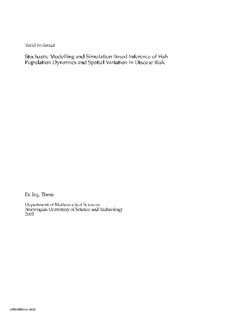| dc.contributor.author | Follestad, Turid | nb_NO |
| dc.date.accessioned | 2014-12-19T13:29:39Z | |
| dc.date.available | 2014-12-19T13:29:39Z | |
| dc.date.created | 2003-04-04 | nb_NO |
| dc.date.issued | 2003 | nb_NO |
| dc.identifier | 125157 | nb_NO |
| dc.identifier.isbn | 82-471-5570-2 | nb_NO |
| dc.identifier.uri | http://hdl.handle.net/11250/249780 | |
| dc.description.abstract | We present a non-Gaussian and non-linear state-space model for the population dynamics of cod along the Norwegian Skagerak coast, embedded in the framework of a Bayesian hierarchical model. The model takes into account both process error, representing natural variability in the dynamics of a population, and observational error, reflecting the sampling process relating the observed data to true abundances. The data set on which our study is based, consists of samples of two juvenile age-groups of cod taken by beach seine hauls at a set of sample stations within several fjords along the coast. The age-structure population dynamics model, constituting the prior of the Bayesian model, is specified in terms of the recruitment process and the processes of survival for these two juvenile age-groups and the mature population, for which we have no data. The population dynamics is specified on abundances at the fjord level, and an explicit down-scaling from the fjord level to the level of the monitored stations is included in the likelihood, modelling the sampling process relating the observed counts to the underlying fjord abundances.
We take a sampling based approach to parameter estimation using Markov chain Monte Carlo methods. The properties of the model in terms of mixing and convergence of the MCMC algorithm and explored empirically on the basis of a simulated data set, and we show how the mixing properties can be improved by re-parameterisation. Estimation of the model parameters, and not the abundances, is the primary aim of the study, and we also propose an alternative approach to the estimation of the model parameters based on the marginal posterior distribution integrating over the abundances.
Based on the estimated model we illustrate how we can simulate the release of juvenile cod, imitating an experiment conducted in the early 20th century to resolve a controversy between a fisherman and a scientist who could not agree on the effect of releasing cod larvae on the mature abundance of cod. This controversy initiated the monitoring programme generating the data used in our study. | nb_NO |
| dc.language | eng | nb_NO |
| dc.publisher | Fakultet for informasjonsteknologi, matematikk og elektroteknikk | nb_NO |
| dc.relation.ispartofseries | Dr. ingeniøravhandling, 0809-103X; 2003:22 | nb_NO |
| dc.subject | | en_GB |
| dc.subject | MATEMATIK | en_GB |
| dc.subject | | en_GB |
| dc.subject | Statistik | en_GB |
| dc.subject | MATHEMATICS | en_GB |
| dc.subject | SOCIAL SCIENCES: Statistics, computer and systems science: Statistics | en_GB |
| dc.title | Stochastic Modelling and Simulation Based Inference of Fish Population Dynamics and Spatial Variation in Disease Risk | nb_NO |
| dc.type | Doctoral thesis | nb_NO |
| dc.source.pagenumber | 217 | nb_NO |
| dc.contributor.department | Norges teknisk-naturvitenskapelige universitet, Fakultet for informasjonsteknologi, matematikk og elektroteknikk | nb_NO |
| dc.description.degree | dr.ing. | nb_NO |
| dc.description.degree | dr.ing. | en_GB |
